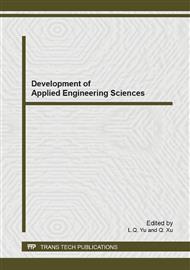[1]
Lai C D, Murthy D N P, Xie M. in: Weibull distributions and their applications. edited by Hoang Pham. Springer Handbook of Engineering Statistics, London: Springer(2006).
DOI: 10.1007/978-1-84628-288-1_3
Google Scholar
[2]
Yun W Y, Murthy D N P, Jack N: Warranty servicing with imperfect repair( International Journal of Production Economics, (2008).
DOI: 10.1016/j.ijpe.2006.12.058
Google Scholar
[3]
Chen M C, Mizutani S, Nakagawa T. in: Random and age replacement policies. International Journal of Reliability, Quality and Safety Engineering, 17(1)(2010), pp.27-39.
DOI: 10.1142/s0218539310003652
Google Scholar
[4]
Pascual F. Accelerated life test planning with independent Weibull competing risks . IEEE : Transactions on Reliability, 57(3)(2008), pp.435-444.
DOI: 10.1109/tr.2008.928205
Google Scholar
[5]
Bebbington M, Lai C D, Zitikis R. A flexible Weibull extension. Reliability Engineering& System Safety. 92(6) (2012), pp.719-726.
DOI: 10.1016/j.ress.2006.03.004
Google Scholar
[6]
L.J. Wei, D.V. Glidden. in: An overview of statistical methods for multiple failure-time data in clinical trials Stat Med, 16 (1997), p.833.
DOI: 10.1002/(sici)1097-0258(19970430)16:8<833::aid-sim538>3.0.co;2-2
Google Scholar
[7]
Attardi L, Guida M, Pulcini G. in: A mixed-Weibull regression model for the analysis of automotive warranty data. edited by Reliability Engineering & System Safety, 87(2)(2005), pp.265-273.
DOI: 10.1016/j.ress.2004.05.003
Google Scholar
[8]
Y.Q. Chen, M. -C. Wang . in: Estimating a treatment effect with the accelerated hazards model Control Clin Trials, 21 (2000), p.369–380.
Google Scholar
[9]
Touw A E. in: Bayesian estimation of mixed Weibull distributions. Reliability Engineering& System Safety, 94(2) (2009), pp.463-473.
DOI: 10.1016/j.ress.2008.05.004
Google Scholar
[10]
W. Nelson. in: Weibull prediction of a future number of failures Quality and Reliability Engineering International, 16 (2000), p.23–26.
DOI: 10.1002/(sici)1099-1638(200001/02)16:1<23::aid-qre283>3.0.co;2-q
Google Scholar
[11]
M. Wirth, C. Tyrrell, M. Wallace et al. in: Bicalutamide (Casodex) 150 mg as immediate therapy in patients with localized or locally advanced prostate cancer significantly reduces risk of disease progression (with Editorial comment)Urology, 58 (2001).
DOI: 10.1016/s0090-4295(01)01213-4
Google Scholar


